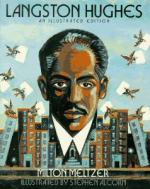|
This section contains 10,647 words (approx. 36 pages at 300 words per page) |

|
SOURCE: Lowney, John. “Langston Hughes and the ‘Nonsense’ of Bebop.” American Literature: A Journal of Literary History, Criticism, and Bibliography 72, no. 2 (June 2000): 357-85.
In the following essay, Lowney discusses the emergence of bebop in the Harlem jazz scene and its relationship to the themes and rhythms of Hughes's Montage of a Dream Deferred.
In terms of current Afro-American popular music and the sources from which it has progressed—jazz, ragtime, swing, blues, boogie-woogie, and be-bop—this poem on contemporary Harlem, like be-bop, is marked by conflicting changes, sudden nuances, sharp and impudent interjections, broken rhythms, and passages sometimes in the manner of the jam session, sometimes the popular song, punctuated by the riffs, runs, breaks, and disc-tortions of the music of a community in transition.
—Langston Hughes, Introduction to Montage of a Dream Deferred
That is where Bop comes from—out of them dark days we have seen...
|
This section contains 10,647 words (approx. 36 pages at 300 words per page) |

|


